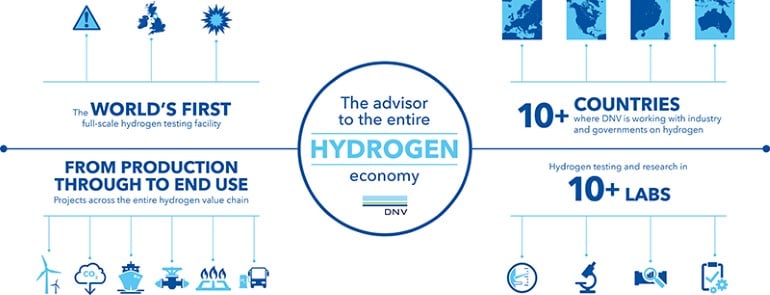What businesses need to know about hydrogen in North America
Hydrogen is crucial to the energy transition, and in recognition the U.S. and Canadian governments have both implemented significant incentives to support its growth.
What you will learn:
- The opportunities and challenges for hydrogen development in North America
- How DNV’s expertise in the end-to-end hydrogen value chain helps businesses create actionable hydrogen feasibility studies
The final energy demand for hydrogen and its derivatives were at near zero in 2022, but will rise to 9% by 2050, as forecast by DNV’s Energy Transition Outlook North America. The expected growth of the hydrogen segment in North America, enabled by government support, provides a unique opportunity for developers, financiers, and utility operators, but they will need to move quickly.
North America’s hydrogen challenges and opportunities
Hydrogen, especially green hydrogen, has long been discussed and considered as an alternative to fossil fuels for many applications, but it has yet to make much progress. There are a number of challenges that must be overcome prior to taking any opportunities. The largest challenge is infrastructure.
Before any hydrogen molecules enter the energy mix at scale, it is critical to understand the feasibility of introducing hydrogen or hydrogen-natural gas (H2 – NG) blends into existing infrastructure, from hydrogen injection to transportation, to end-use appliances. The first step is a feasibility study, which assesses the material and equipment compatibility of the network with hydrogen to determine an acceptable range of hydrogen concentration (H2%) that could safely be added to the system with modest levels of investment and modifications. It investigates a number of aspects, including material integrity, equipment accuracy and functionality, chemical compatibility, storage and handling, and customer end-use applications.
The second challenge, once you’ve proved that hydrogen can flow safely through your systems, is gaining public acceptance and local community buy-in. Many communities have begun to aggressively oppose clean energy projects due to real or perceived risks and impacts. Sentiment has started to evolve from NIMBY (Not in My Back Yard) to BANANA (Build Absolutely Nothing Anywhere Near Anything), and when coupled with hydrogen’s already poor reputation with the public (thanks to the Hindenburg and its flammable membrane), stakeholder management becomes paramount. Failure to understand and address community positions, interests and needs poses a risk to project economics and delivery.
However, it is not all that bad. The opportunities. thanks to government incentives, are large, and it is essential to ensure your hydrogen project capitalizes on the full suite available. As DNV’s Energy Transition Outlook report says, “Carbon-free power sector targets (U.S. by 2035, Canada 90% by 2030) facilitate hydrogen efforts, as do strong CCS policy with R&D funding, requirements, and economic instruments (e.g. the U.S. Section 45V tax credit and grants).” Over the next 30 years, we expect that this government support combined with natural efficiency gains through scaling and technology advancements will see the levelized cost of green hydrogen falling to $4 or less, depending on the type of renewable power, and the grid connected hydrogen becoming more cost-efficient than blue hydrogen.
Unrivalled expertise in hydrogen
DNV’s multi-disciplinary local teams can be quickly mobilized to perform technical, commercial, regulatory and environmental studies within short timeframes. Our local teams are supported by a global network of renewable energy, oil & gas, maritime, digital solutions and cyber security subject matter experts. Additionally, our laboratories provide the latest research on all aspects of hydrogen production, delivery and offtake.
We partner with developers, financiers, and utilities to create a customized hydrogen roadmap that combines the system compatibility assessment with the operator’s hydrogen goals to create a practical and actionable path forward to hydrogen integration. DNV’s local experts are also uniquely positioned to educate and inform local communities about the benefits of hydrogen and safe, responsible hydrogen operations. We also provide advisory services to help clients navigate new and evolving industry standards and as well as capitalize on all available incentives.

Watch this can't miss webinar "Fueling the future: the hydrogen feasibility journey begins!" focussing on the main factors to consider when developing a hydrogen feasibility assessment for introducing hydrogen or hydrogen-natural gas (H2–NG) blends into existing gas infrastructure and the long term challenges, opportunities, and risks to plan for over a hydrogen project lifecycle that will inspire confidence among your colleagues, executives, and investors.
You can also read more on our website about the four key areas industry and governments must focus on to scale hydrogen production.
1/30/2024 9:00:00 AM
